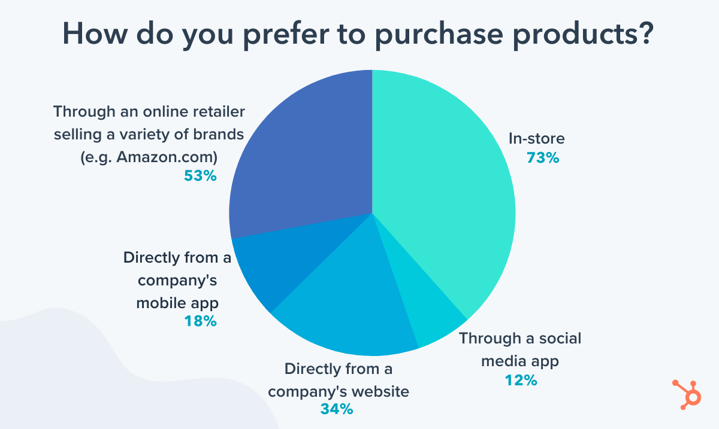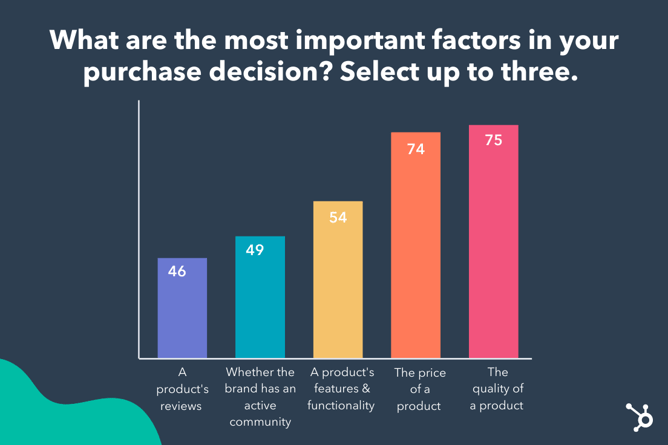Top Shopping Trends of 2023 & How They've Changed [New Data]
Shopping trends have drastically changed over the past few years. While most of us previously browsed retail stores on a Saturday to find great deals, we now turn to Instagram to find discounts offered by influencers.
![Top Shopping Trends of 2023 & How They've Changed [New Data]](https://blog.hubspot.com/hubfs/Shopping%20trends%202023.png#keepProtocol)
Shopping trends have drastically changed over the past few years. While most of us previously browsed retail stores on a Saturday to find great deals, we now turn to Instagram to find discounts offered by influencers. And rather than watching TV ads to find out about new products, nowadays, most of us stumble across ads in between YouTube videos. Here, we'll explore the shopping trends of 2023, as discovered in our State of Consumer Trends Survey, to ensure you're able to meet customers where and when they'd prefer to shop. Let's dive in. How Shopping Trends Changed in the Past 6 Months The Top Shopping Trends of 2023 The Shopping Trends to Expect in 2023 These days, consumers have a lot of flexibility in how they purchase products. They can make a one-time purchase or join a subscription service. They can also pay full-price or via installments thanks to popular platforms like Afterpay and Klarna. However, this flexibility may not be necessary. While 32% of consumers have purchased a subscription over the past three months, a staggering 69% of consumers still prefer purchasing products whenever the need arises. On top of that, consumers prefer to purchase products at full price. Only 21% of consumers prefer purchasing a product with installments. According to our report, a slim 6% of Baby Boomers feel comfortable making purchases directly on social media. What's more, only 5% trust social media platforms with their credit card information. In short, Baby Boomers are skeptical about shopping via social media. However, things could be turning around. 24% of Baby Boomers have discovered a new product on social media in the past 3 months — up 41% from May 2022. On top of that, 6% of boomers have bought a product on social media in the past three months, a 50% jump from May 2022. While these stats are promising, it's important to meet your consumers where they are right now. So, if you're audience skews older, you might get more traction with other channels like TV ads and search. Increasingly, consumers want to support companies that share their values. For example, 66% of consumers want companies to reduce their environmental impact. This isn't just talk: corporate responsibility is influencing consumers' purchasing decisions. Take a look at these stats: At the same time, consumers are skeptical of companies that use social issues as a marketing ploy without actually taking meaningful action. But when a company takes a genuine stand, it can be an effective way to build trust and credibility with consumers. Influencer marketing has proven an incredibly effective strategy for brands over the past few years — in fact, as of 2021, almost 60% of marketers said influencer marketing was the most effective marketing trend, ahead of SEO, experiential marketing, and short-form video content. And in 2022, 30% of consumers now report influencer recommendations are one of the most important factors in their purchasing decisions, compared to 27% for recommendations from friends or family. In many ways, this makes sense: Influencers are traditionally considered experts in their niche. If I follow a makeup influencer, it's safe to assume he or she knows more about makeup than most of my friends. For e-commerce businesses, this is powerful news: It means you no longer need to rely on word-of-mouth alone. Instead, it's wise to focus your efforts on influencer marketing, since influencers have demonstrated a level of influence over their audiences that surpasses even that of friends and family. Our State of Consumer Trends Survey found Gen Zers (ages 18-24) most often discover new products on social media (71%), followed by YouTube ads (56%), ads on music streaming services (55%), and internet searches (50%). If your e-commerce business is targeting Gen Zers, then, it's vital you focus your efforts on social media rather than paid ads when it comes to attracting new leads to your products and educating those leads on your products. Additionally, when asked which content formats Gen Zers prefer for learning about a product and its features on social media, roughly 50% said they'd like to learn about a product through a story post. This is followed by short-form video (42%), and then a feed post (42%). However, 73% of people (and 55% of Gen Zers in particular) say they'd still prefer to purchase a product in-store. This is an important call-out: While you'll want to focus on social media for your lead generation efforts, it's still vital to have a strong, effective in-store shopping option for those who would like to make the final sale in person. Similar to Gen Zers, the most popular method among millennial buyers for discovering new products is social media (51%). However, in a close second for millennials is searching the internet (50%) — which means, if you're targeting a millennial demographic, you might want to consider leveraging paid ads and a strong SEO strategy for getting your products in front of your target audience. And if your target audience is Gen X (35-54 year olds), retail stores are the most popular option for discovering new products, so you'll want to invest time and resources in partnerships with brick-and-mortar retailers to ensure your products are at plenty of physical locations. Plus, similar to millennials, 39% of Gen X buyers also search the internet for new products, so SEO is another good option here. Depending on your target demographic, you'll want to vary the type of content you create for social media when it comes to attracting new audiences to your products. For instance, if you're aiming to attract Gen Zers, you'll want to consider short-form video like TikTok or Instagram Reels, since 41% report short-form video as their preferred medium for discovering new products. If you're instead looking to reach millennials or Gen Xers, you'll want to think about leveraging ads or sponsored content, since 44% mark that option as their favorite. When shopping online, roughly 75% of consumers prefer using their mobile devices, compared to 15% that prefer desktop and 6% that prefer tablet. This means as an e-commerce business it's critical your website is mobile-optimized, and you have mobile-responsive product pages. If I'm scrolling a company's products and I find it's too difficult or cumbersome on my phone, I typically ditch the website – and don't return. So it's vital you ensure you're following mobile best practices (including large text, lots of white space, responsive templates, and mobile-friendly calls-to-action). Across the board, price is a major factor when it comes to purchasing decisions. 78% of Gen Z, 74% of millennials, 74% of Gen X, and 73% of Boomers report price as one of the most important factors when it comes to deciding whether or not they're going to buy a product. The quality of a product is important, as well, with 65% of Gen Z, 78% of millennials, 82% of Gen X, and 72% of Boomers marking it as another top factor when it comes to purchasing decisions. But beyond having a reasonably-priced and high-quality product, there are a few other distinguishing factors you'll want to keep in mind when marketing your brand. For instance, 57% of Gen Zers will consider purchasing a product if a percentage of the proceeds from the purchase will be donated to charity. And 55% of millennials prefer buying a product that has strong reviews. 62% of Gen Xers appreciate whether a brand has an active community around it, and 55% of Boomers look for a product's features and functionality when considering a purchase. Short-form video is the most popular video length on social media. As a result, TikTok — and other short-form video platforms — are becoming viable advertising channels. In fact, 36% of consumers want to learn about products through short-form videos like TikToks or Reels. On top of that, 52% of U.S TikTok users say the advertisements they see on the platform are fun and engaging — which are two ingredients for effective ads. Here are a few trends you'll continue to see: When creating an effective e-commerce strategy, it's vital you take the time to understand how shoppers want to shop today — and into the future. Shopping behaviors change over time. The more your business can meet the evolving needs of your consumers, the more likely you are to continue to succeed well into the future.
![The State of U.S. Consumer Trends [Free Report]](https://no-cache.hubspot.com/cta/default/53/ebf9ec8e-a468-455a-943e-80aa4e6be694.png)
Table of Contents
How Shopping Trends Changed in the Past 6 Months
1. Consumers prefer flexibility over subscription models.
.png?width=2000&height=800&name=Shopping%20trends%20(2).png)
2. Baby Boomers are skeptical about shopping via social media, but they're coming around.
3. Millennials and Gen Z'ers may hinge their purchasing decisions on a company's stance on social issues.
The Top Shopping Trends of 2023
1. Influencer recommendations matter more than recommendations from friends and family.
2. Gen Zers prefer to discover new products via social media — but they still like to make purchases in-store.

3. When it comes to millennials and Gen X, retail stores and searching the internet are two popular options for discovering new products.
4. Millennials and Gen Xers prefer to discover new products on social media through ads or sponsored content — while Gen Zers prefer discovering new products on social media through short-form videos.
5. Mobile phones are the most popular device for online shopping.
6. Price matters most to when it comes to making a purchasing decision — but other factors might surprise you.

7. Short-form video offers huge advertising opportunities.
The Shopping Trends to Expect in 2023

 ValVades
ValVades 










![How to Create Detailed Buyer Personas for Your Business [Free Persona Template]](https://blog.hubspot.com/hubfs/buyer%20personas.jpg#keepProtocol)






















